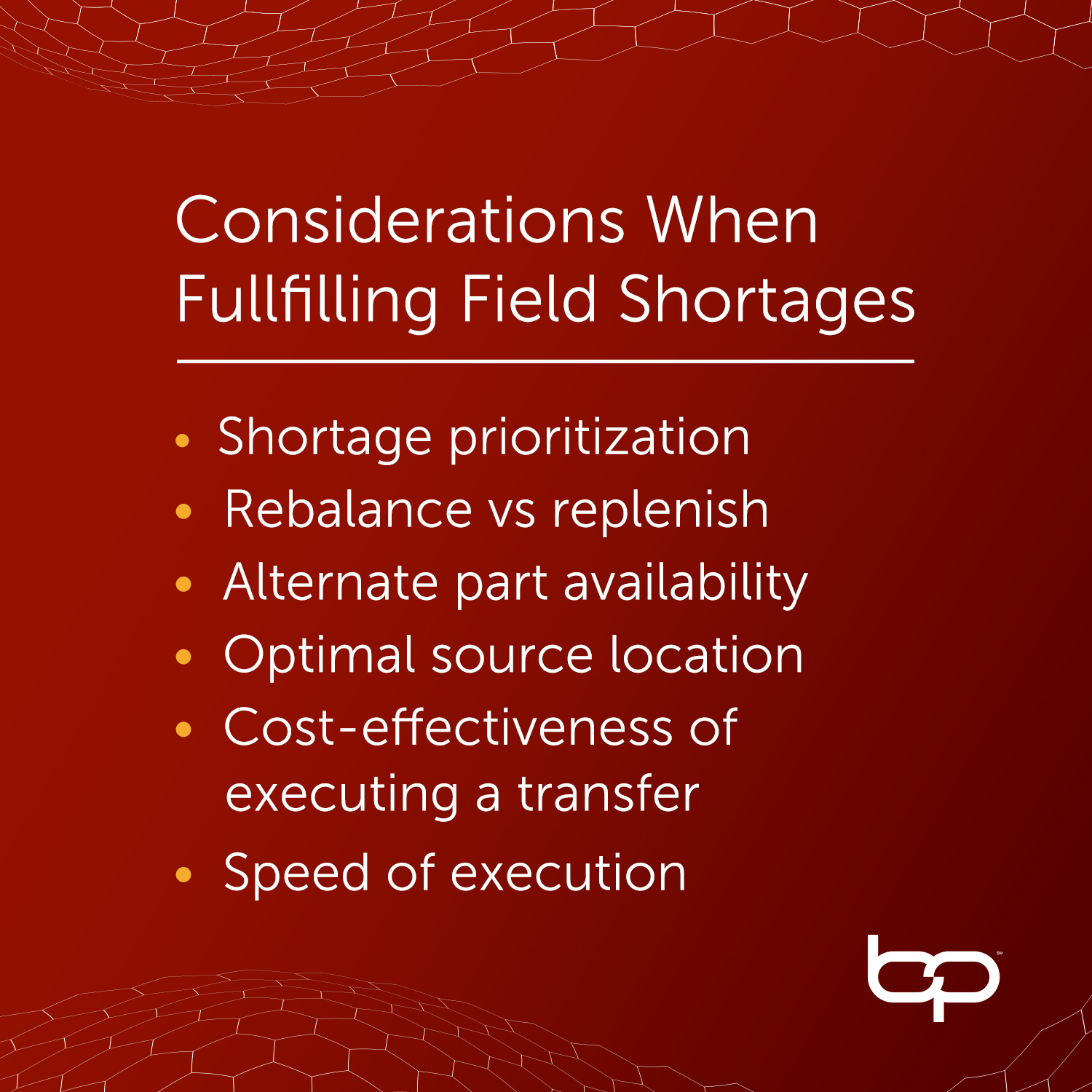Prioritized Restocking of Distributed Re-Order Point (ROP) Locations
Remember the old days when we experienced supply shortages? When inventory balances were sometimes inaccurate, and suppliers shipped short or missed due dates?
Wait, we still have those issues, don’t we? Well, I suppose we just have to keep getting better at dealing with them, then.
Restocking Re-Order Point (ROP) locations—forward stocking, remote warehouses, storage lockers, technician trunk stock, customer on-site, etc.—seems like a simple enough task. Just determine where the shortages are and fill them, right? But when you dig into it, it’s anything but simple.
Complexity arises not only from the process, but from the volume of decisions that surround it. If you have twenty or more forward-stocking locations in multiple countries, then you know what I mean.
Let’s break the process down into steps and explore each one:
- Determine where the shortages are.
- Prioritize those shortages.
- Determine the optimal location from which to source the material.
- Create the order.
- Repeat.
Determine What and Where the Shortages Are
A shortage is simply when your on-hand inventory balance falls below your target stock level. Or is it?
First off, let’s not make the mistake of thinking that a location requires a part replenishment just because a part has been consumed from that location. Each replenishment cycle must include a fresh comparison of the on-hand (OH) balance to the calculated target stock level (TSL), in case that TSL has changed. In addition to the on-hand balance, you must consider any shipments that are in transit to the location, the quantity on order (OO). So, the formula to keep in mind is “OH + OO – TSL = Replenishment Quantity.”

Prioritizing the Shortages in the Network
Not all shortages are created equal. Historically, many replenishment processes followed a “first ordered, first shipped” methodology, or worse yet, a “squeaky wheel gets the grease” pattern. An ideal replenishment approach considers the opportunity costs of executing various replenishments. That means determining the most critical shortage and prioritizing it to be sourced first, and so forth. If you have plenty of available inventory to fulfill all shortages, then there is no issue. But if you don’t have enough inventory to fulfill all shortages, you must make sure the most critical locations are fulfilled first and that any shortages left unfulfilled are the least critical. You must also be able to comprehend the relative criticality of each shortage for the same part number at any given location.
For example, if you have TSL of two for a part at a location and the OH + OO = 0, fulfilling the first shortage (to bring OH to 1) may be significantly more critical than fulfilling the second shortage (to bring OH to 2). In this scenario, the second shortage may go unfulfilled if there’s a material constraint.

Determining the Optimal Source Location
A common methodology might be to replenish all field shortages from the central distribution center (DC), but the better approach is to first utilize any excess from other field locations.
This excess can arise from decreases in demand or changes to customer service level agreements (SLAs). Sourcing from other locations can improve your process in a couple of ways. First, you clear excess out of field locations that’s otherwise difficult to utilize and you reduce the risk of that inventory becoming obsolete due to revision change or other reasons. Second, the inventory at a central DC is typically more flexible. In the case that you need to make an emergency shipment, the DC is better suited as the shipping source because it typically has more robust staffing, extended hours of operation, and proximity to transportation hubs.
Once you’ve made the strategic decision to source shortages from other field locations, it’s time to determine which one. To reduce transportation time and cost, you want to source from the over-stocked location that’s closest to the field shortage. To facilitate this, a prioritized ship-from matrix needs to be in place for each location in the network, starting with the closest one and ending with the farthest one that’s eligible to ship. Eligible to ship? Yes, you must consider, for example, if these locations can ship across international borders, or if there are other constraints, like unstaffed stocking locations. Of course, your central DC can and should be part of that matrix. Do you have field engineers or service technicians carrying inventory as part of your network? Field techs have a knack for accumulating excess inventory, but consider carefully how you include them into your sourcing matrix. You certainly want engineers to automatically receive the materials they need, but turning them into shipping clerks isn’t an effective use of their time. Part chaining, or supersession, also comes into play here because you want to consider equivalent parts that may be stocked under a different part number. But that’s a can of worms for a different post.
Creating the Order
You now have a prioritized list of part/location shortages and the source part/location for each. It’s a simple matter of creating, hopefully automatically, all the shipment or transfer orders and distributing them to the appropriate locations. But wait. As usual, there’s more. Fulfilling every shortage isn’t always the optimal solution. Consider, for example, if the shipping cost outweighs the benefit of filling the shortage. In that case, it may be more cost effective to hold that part at the shipping location. In some small percentage of circumstances, you may wind up expediting a part to the shortage location to fulfill a customer SLA. If you’re doing this complete replenishment analysis daily, it could be that tomorrow there are two parts that can ship from point A to point B, and that becomes a cost-effective shipment to execute.
Rinse and Repeat
The replenishment process as outlined above typically occurs on some sort of schedule—maybe daily, weekly, or bi-weekly. In any case, when calculating your optimal TSLs, it’s important to consider the review time between cycles plus the standard transportation time.
Keep in mind that longer total replenishment leadtimes demand higher TSLs to account for demand variations. One key step in reducing the total replenishment leadtime is being able to execute the process—from analyzing the shortages to executing the physical shipment—in a timely manner. It’s optimal to ship replenishment material the same day the shortage is created. If you use yesterday’s ending inventory balances to do your analysis, consider that those few hours between close of business and start of business equate to one full day of additional replenishment leadtime.
The complexity and the detail required to optimize the replenishment process shouldn’t be underestimated, and anything short of full automation can quickly become too burdensome and error prone.
In summary, a process as seemingly simple as replenishing field shortages can still be optimized to balance your inventory costs, transportation costs, and customer satisfaction.

John P. Peterson III, CPIM
Enterprise Solutions Consultant
John is a supply chain professional with more than 30 years of experience; 25 years focused on the service supply chain. In 20 years at Baxter Planning, he has leveraged his expertise and experience to drive Implementations, Consulting, and Planning engagements.
In his current Enterprise Solutions Consultant role, John serves as a subject matter expert providing technical demonstrations and solutions development in support of our sales team. He continues to do extensive work on independent inventory analysis projects, to date identifying over $1B in inventory optimization opportunity alongside the opportunity to reduce service misses due to inventory shortages by over 30%. In 2019, John was named as a Supply Chain “Pro to Know” by Supply Chain & Demand Executive magazine.
Certified in Planning and Inventory Management by ASCM (formerly APICS), The Association for Supply Chain Management, John has served on the Board of the Dallas and Austin, Texas ASCM (formerly APICS) chapters.
John lives in the Austin, Texas area with his wife, Lisa, with whom he has twin sons. He enjoys spending downtime motorcycling through the Texas Hill Country, drumming, and ‘glamping’ around Texas.

